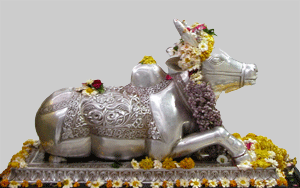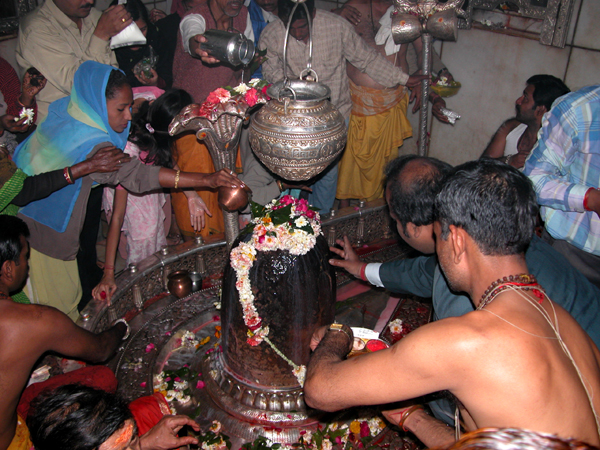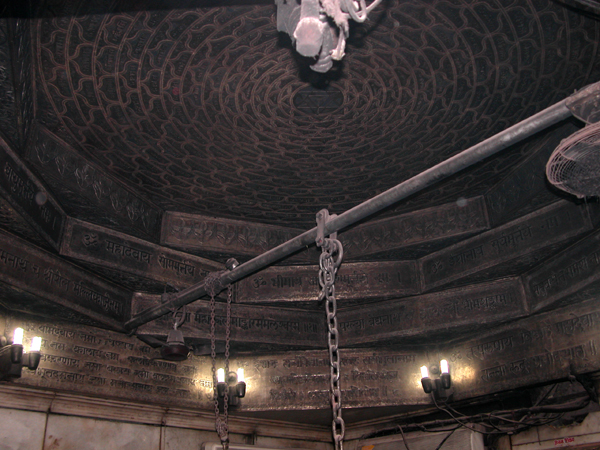|
|
The Mahakaleswar Jyotir Lingam Temple, Ujjain, Madhya Pradesh |
|
|
|
|
|
|
|
The Mahakaleswar Jyotir Lingam Temple, Ujjain, Madhya Pradesh |
|
|
|
|
|
|
The Mahakaleswara Jyotir Lingam |
|
|
|
The Mahakaleswara Shiva Lingam is one of the largest of the twelve Jyotir Lingams, being apr. 60cm high, only Sri Somnath is bigger. The Lingam is believed to be Swayambhu (born of itself), deriving its Shakti or power, from within itself. A unique feature of this majestic shrine is that the idol faces the south, a positioning upheld by the Tantric tradition and found only in Mahakaleshwara among the 12 Jyotir Lingams. The
main Sanctum Sanctorum remains dark even during the day, therefore
two lamps are always burning. |
|
Mahakal = Grand Time or Lord of Time |
|
It is said that in ancient times,
according to the then time zone division, the zero degree longitude passed through Ujjain, which were believed to be the
central point of the Aryavata.
The time reckoning
point was in Ujjain. Hence the establishment of the Mahakal Temple. Maaha Kaala
litterally means the
Grand Time or
Lord of Time. The theory seems plausible as Ujjain has been and still is a seat of astrology and Indian astronomy having a
Nava Graha, a
Nine Planet temple and an observatory. |
|
Legend |
|
There once lived a
Brahmin in Avanti, who
had four sons, who were great devotees of Lord Shiva. Dushanan, a demon was
giving trouble, disturbing all good and religious activities. The Brahmins from
all over the land gathered with the four sons and performed Puja to Lord Shiva.
The spot where they had taken mud to make the Lingam, became a huge pond.
When Dushanan came to disturb their Puja, Lord Shiva rose from this pond as Mahakaleshwara and
destroyed Dushanan. On the request of the Brahmins, Lord Shiva
gave Darshan to devotees at this Jyotir Lingam Sthalam. |
|
Darshan |
|
Those
who visit the Mahakal Temple and take Darshan, will newer be touched
by sorrow even in their dreams. Those who pray for whatever they
desire to the Mahakal Jyotir Linga will be granted all his/her
wishes and attain salvation. By the Darshan an untimely death is
avoided. All
those who pray to this Linga will
never fear death and if their faith is true, they will be out of the Chakra of
life and death. |

|
The Mahakaleswara Temple |
|
|
|
The Mahakaleswara Temple is situated in Ujjain, Madhya Pradesh, one of the seven most holy cities of the Hindu faith in India. The temple is situated near a lake formed by the river Kshipra. The Mahakaleswara Temple is one of the 18 Shiva-Shakti Peetahs in India. Two other Jyotir Lingam temples are Shiva-Shakti Peethas, the others being the Mallikarjuna Temple, Sri Sailam, Andhra Pradesh, and the Vishwanatha Temple in Kasi / Varanasi, Uttar Pradesh. The Mahakaleswar temple, dedicated to Lord Shiva was rebuilt by Marathas in the 18th century. Historically not much is known about the origin of the temple prior to the resurrection by the Scindias of Gwalior. The earlier shrine was demolished or rendered to a dilapidated condition by the Slave Sultan Altamish in 1235AD. The Mahakaleswar temple is built in five stories. The main underground temple houses the idol of the Swayambhu Mahakal Diety where two lights is always lit. The idol of Omkareshwar Shiva is consecrated in the sanctum above the Mahakaleswara shrine and the images of Lord Ganesh, Parvati and Kartikeya are in the west, north and east of the Sanctum Sanctorum. To the south is Shiva's bull, Nandi. Nagchandreshwar is on the upper floor. The Theertam opposite the Mahakaleshwarar temple is known as Koditheertham and it is said that the colour of the waters of this Theertham keeps changing. Every
Mahashivratri, in the month of March, pilgrims by the thousands
gather at the fair held near the temple. |
|
A walk in the temple premises |
|
|
|
|
|
|
|
|
|
"Downstairs" Darshan of the Jyotir Lingam |
||
|
|
||
|
|
||
|
|
||
|
|
||
|
|
||
 Devotee doing Abisheka and offering prayers |
||
|
||
 The ceiling in the Sanctum Santorum with inscribtions |

Steps leading from the shrine back and up into the street

The Mahakal underground Sanctum seen from the street

Beauty

Temple tops of the smaller shrines at the compound

Temple seen from a nearby hotel balcony
|
Ujjain - The city of the Gods |
|
Ujjain, Madhya Pradesh, one of the best known cities of ancient India, is situated on the right bank of the River Kshipra. Ujjain was a prosperous city in ancient India as it was situated on a flourishing trade route to Mesopotamia and Egypt. There is an interesting tale behind the sanctity of the city. Its origin is ascribed to the mythological legend of Sagar Manthan (churning of primordial ocean to discover the pot of nectar). The story goes that after the nectar was discovered, there was a chase between the gods and demons to have the nectar first and thus attain immortality. During this chase a drop of nectar spilled and fell on Ujjain, thus making the city sacred. Usually there is a temple built in a village, or a village exists for the temple. Sometimes a village or city is full of temples. As one of the seven Moksha Sthalams* or cities of deliverance or salvation, Ujjain has several very holy temples and places: 7 Sagar Teerthas, 28 Theerthas, 84 Siddha Lingas, 25-30 Shiva Lingas, Ashtabhairav, Ekadasa Rudrasthana, temples for hundreds of Deities, Jalakund and monuments are there. Ujjain is also called Indrapuri, Amaravati or Avantika Nagar. In ancient litterature the city was also called Vishaala. Legend has it that Shiva commemorated his victory over the demon ruler of Tripuri by changing the name of his capital from Avantika to Ujjaini, which means, One who conquers with pride. Ujjain is also famous for its two Kali temples. One for Kali Devi Harasiddhi Matha, who gave darshan to king Vikramaditya, who is believed to have held court in this city, and a temple for the Mahakali who gave Darshan to the poet Kalidasa. Kalidasa is one of the Nava Ratnas (Nine Gems) of Hindu literature, and some of his work is written in Ujjain. Many dynasties ruled over this prosperous city, and it is also said to have been the seat of the viceroyalty of Ashoka around 275BC. His sons were born here, and it was from here they set out to preach Buddhism. Kings like Bhooja and many more pious people and saints has been living in this city. Astrologically Ujjain stands on the first meridian of longitude for Hindu astronomers, who believe that the Tropic of Cancer also passed through the site. This explains the presence of the Vedha Shala observatory, southwest of the town, built by Raja Jai Singh II of Jaipur around 1730. Even today the Ephemeris tables (predicted positions of the planets) are published here. *The other 6 Moksha
Sthalams are: Varanasi, Allahabad, Nasik, Haridwar & Rishikesh |
|
Kumbha Mela |
|
The Kumbha or Simhastha Fair of Ujjain comes every twelve years when Jupiter enters the sign of Leo. Simhastha means placed in the Simha (Leo) sign. On this day millions of people come to have a holy dip in the Kshipra River. Hindu legend tells that during a war over the urn (Kumbh) of immortal nectar (Amrit) between the gods and demons, Vishnu gave the urn to Garuda, his winged mount. During his flight, four drops of the nectar fell on four places, Nasik, Ujjain, Haridwar and Allahabad. Kumbha Mela is held
at each spot in turn every three years, when certain planetary
configurations transforms the waters of Ganges into Nectar. Pilgrims
from all over India, converge at the Kumbha Mela to wash away their
sins, making it the worlds largest religious gathering. Specially
built tent cities and stalls spring up to cater the influx. The last
Kumbha Mela held in Ujjain was in 2004. |
|
|
|
|
OM Namah
Shivaya
mukti4u2.dk ► created by BP